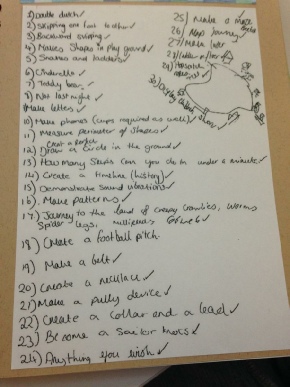
Site Content ©2015 Matt Jolly, Gee King, Josh Fewtrell, Jemma Aldridge all rights reserved. Photographs ©2015 Paul Jolly all rights reserved.
Initial ideas
Having realised that we were struggling to make any progress in our work with the BHF, we decided to take our project in a new direction. After a discussion with our tutor we made the decision to create a book about things that can be done with rope. Our main inspiration was ‘The Stick Book’ by Fiona Danks and Jo Schofield. It was full of activities and games that could be done using a stick and was presented in an easily accessible and clear layout. It was also littered with brightly coloured, energetic pictures that really captured our imaginations.
With this new focus, we decided to brainstorm some ideas. First of all we thought about our target audience and book style. We thought that the book should be written for adults who wanted activities to do with children; specifically teachers and parents. This meant that we would be using adult language and vocabulary when writing, but would still place an emphasis on the enjoyment children would get.
Then, each of us came up with our own list of things to do with rope. However, we realised that our selection was quite limited. To overcome this problem, we thought that we should expand our initial book idea to include activities that also used string. We then did another brainstorm and were surprised to find that we had a list of over 70 different activities and ideas that could go in our book.
It was at this time that we also came up with the title for the book. We wanted something simple that still managed to sum up the book as a whole. In the end we went for ‘Get Roped In’ as we found the play on words to be quite amusing and thought that other people would too.
After having gathered all of our ideas together we started to plan how we would do each one. For example, we decided that the idea ‘displaying work’ was quite boring and would not suite the style of the book, so we got rid of it. And we realised that our knots section would be much better if we explained the process in a video and published the links.
The final stage in the planning was to consider how we would section the book. At the start we would obviously have a front cover and a contents page. We also added in an acknowledgements section and some advice on health and safety. We then decided to split the activities into several different sections to give the book more focus. For example, our Arts and Crafts section has activities such as making Dream Catchers.
With these initial plans completed we moved onto the task of actually making the book. This ended up being a lot more complicated than we first thought.

